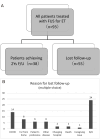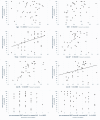Outcomes and Prognostic Factors of Magnetic Resonance-guided Focused Ultrasound Thalamotomy for Essential Tremor at 2-year Follow-up
- PMID: 38355128
- PMCID: PMC11099165
- DOI: 10.2176/jns-nmc.2023-0202
Outcomes and Prognostic Factors of Magnetic Resonance-guided Focused Ultrasound Thalamotomy for Essential Tremor at 2-year Follow-up
Abstract
Magnetic resonance-guided focused ultrasound (MRgFUS) thalamotomy is an effective treatment for essential tremor (ET). However, its long-term outcomes and prognostic factors remain unclear. This study aimed to retrospectively investigate 38 patients with ET who underwent MRgFUS thalamotomy and were followed up for >2 years. The improvement in tremor was evaluated using the Clinical Rating Scale for Tremor (CRST). Adverse events were documented, and correlations with factors, such as skull density ratio (SDR), maximum mean temperature (T-max), and lesion size, were examined. Furthermore, the outcomes were compared between two groups, one that met the cutoff values, which was previously reported (preoperative CRST-B ≤ 25, T-max ≥ 52.5°C, anterior-posterior size of lesion ≥ 3.9 mm, superior-inferior [SI] size of lesion > 5.5 mm), and the other that did not. The improvement rate was 59.4% on average at the 2-year follow-up. Adverse events, such as numbness (15.8%), dysarthria (10.5%), and lower extremity weakness (2.6%), were observed even after 2 years, although these were mild. The factors correlated with tremor improvement were the T-max and SI size of the lesion (p < 0.05), whereas the SDR showed no significance. Patients who met the aforementioned cutoff values demonstrated a 69.8% improvement at the 2-year follow-up, whereas others showed a 43.6% improvement (p < 0.05). In conclusion, MRgFUS is effective even after 2 years. The higher the T-max and the larger the lesion size, the better the tremor control. Previously reported cutoff values clearly predict the 2-year prognosis, indicating the usefulness of MRgFUS.
Keywords: ablation; essential tremor; focused ultrasound; outcome; prognostic factor.
Conflict of interest statement
The authors declare no competing interests.
Figures





References
-
- Elias WJ, Lipsman N, Ondo WG, et al. : A randomized trial of focused ultrasound thalamotomy for essential tremor. N Engl J Med 375: 730-739, 2016 - PubMed
-
- Elias WJ, Huss D, Voss T, et al. : A pilot study of focused ultrasound thalamotomy for essential tremor. N Engl J Med 369: 640-648, 2013 - PubMed
-
- Chang JW, Park CK, Lipsman N, et al. : A prospective trial of magnetic resonance-guided focused ultrasound thalamotomy for essential tremor: Results at the 2-year follow-up. Ann Neurol 83: 107-114, 2018 - PubMed
-
- Meng Y, Solomon B, Boutet A, et al. : Magnetic resonance-guided focused ultrasound thalamotomy for treatment of essential tremor: A 2-year outcome study. Mov Disord 33: 1647-1650, 2018 - PubMed

